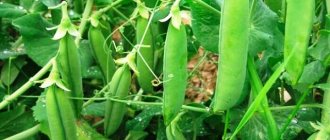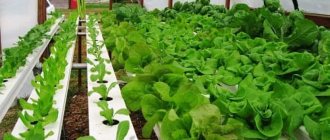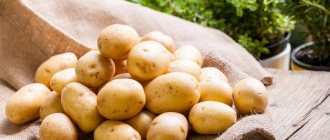What are green manures and what are they for?
Green manure works according to the following principle:
- sowing crops;
- cultivation before the flowering process begins;
- cutting, incorporating green mass into the soil.
This technique saturates the soil with mineral and organic substances before planting the main crops. It is recommended to use green manure in the fall. Long-term observations show that the result of sowing green manure at the end of August or September gives a greater effect than spring planting.
Green manure is selected depending on the crop being grown and the structure of the soil.
To select green manure for potatoes and obtain first-class tubers, you need to know what the crop needs.
No. 1. White mustard
In my opinion, regular mustard is the most effective green manure for potatoes . So, when applying this green fertilizer during the flowering period, the soil receives 10-12 grams of nitrogen, 14 grams of potassium and about 2 grams of phosphorus per square meter of bed, and in the most easily digestible form for plants.
This allows you to get a 50-70% increase in yield even without introducing additional doses of organic matter into the soil - manure, compost.
Mustard as a green manure for potatoes has several other undoubted advantages:
- It enriches the soil with a large amount of organic material, which over time is processed by soil bacteria into neutral humus. So, in just a month from the moment of germination, mustard gains up to a kilogram of green mass per square meter of land.
- The powerful branched roots of mustard loosen the soil to a good depth, making it more air- and water-permeable.
- The leaves and stems of mustard contain a special essential oil, whose smell is disliked by many pests - for example, the Colorado potato beetle and wireworm. Thanks to this, potatoes also suffer less from late blight, and tubers are not affected by rot and scab.
- This green manure crop helps clear the area of annual and perennial weeds.
In the middle zone, mustard is sown until the second ten days of September, since the seeds of this plant begin to hatch already at a temperature of +1...2 degrees, and young seedlings easily tolerate frosts down to -6 degrees.
Mustard is sown immediately after harvesting the potato crop. The seeds are sprinkled with a layer of soil no more than two centimeters. Shoots usually appear after 5-7 days. Mustard plantings do not require any special care.
How to sow mustard before winter and whether it is worth doing it at all, read the article - “Sowing mustard before winter: all the pros and cons.”
When is the best time to plant green manure for potatoes?
Let us dwell in detail on the use of green manure in the spring, before planting potatoes, and in the fall, after harvesting. What is the difference, how to choose the right green manure for each period?
Planting green manure in autumn
As noted earlier, autumn is the most favorable period for planting green manure crops. It is important to sow in a timely manner in order to obtain fertile soil in the area where you plan to plant potatoes by the next growing season.
The choice of planting dates depends on the climatic conditions of the region. For the middle zone, this is the first ten days of September. There should be approximately a month and a half left before frost.
Rules for planting green manure:
- treat the soil - dig it up and loosen it. You should not dig the ground to a depth of more than ½ spade bayonet;
- on the prepared soil, make grooves up to 4 centimeters deep;
- distribute the seeds evenly over their surface;
- sprinkle the seeds with a layer of compost about 10 centimeters thick;
- The green manure will emerge in May and will continue to develop further. It must be mowed and embedded in the soil;
- After a couple of weeks, you can plant sprouted potato tubers in the prepared soil.
This information brings clarity to the question: what is the essence of autumn cultivation of green manure for potatoes. Before frost hits, green manure seedlings have time to gain strength and winter successfully. In the spring, as soon as the snow melts, the plant continues to gain green mass. It is cut off and left on the surface of the site. The root system continues to extract nutrients. Later, when the roots decompose, they will go into the soil and serve as a source of nutrition for the potatoes.
Autumn green manure can be anything. They primarily improve soil fertility.
Planting green manure in spring
In spring, seeds are planted in the ground only after the ground has warmed up. Each region has its own timing for sowing green manure. Most often this happens in the first half of April. It will take at least a month for the culture to reach the required stage of development. As soon as the green manure begins to bloom, it is mowed. It will take another couple of weeks for the plant residues to decompose. After this, you can start planting potatoes.
As you can see, green manure is running out of time to gain green mass. Legumes are suitable for spring sowing. Of the cereals, oats have proven themselves positively. Cruciferous crops can be used.
If the soil on the site is poor, it is recommended to use green manure in the summer. Vetch is sown between the rows of potato plantations at the very beginning of summer. In July, radish is used as green manure. At the end of the growing season, in August, mustard is sown between the rows. Such support helps the plant form healthy and complete tubers.
When and how to sow correctly
It is not enough to choose suitable green manures; you also need to sow them on time and correctly.
Spring planting
In the spring, green manure for potatoes can be sown after the snow has melted and the earth has warmed up to 10°C. It is necessary to plant in soil fertilized with mineral fertilizers: the plants will process them and convert them into organic form. There are two ways to sow green manure before potatoes: put the seeds in shallow grooves, and then sprinkle them with soil, or simply scatter them over the surface of the beds, sprinkle them with peat or humus. After this, they must be watered. If it is too warm and the soil dries out quickly, you will have to water it several more times after germination.
By the way, it is not necessary to dig up green manure in the spring: you can plant potatoes in the holes, mow the greens and lay them as mulch. You can mow it manually with a sickle or lawn mower. If a lot of greenery has grown, some can be spread out on other beds.
We recommend reading
What fertilizers can be used to feed potatoes?
Features of germinating potatoes before planting
When can you start digging potatoes?
Rules for storing peeled potatoes
Autumn planting
You need to sow green manure in the fall after harvesting potatoes at least 1.5 months before a steady cold snap. This is necessary so that they have time to emerge, grow to about 20 cm, and after mowing and surface embedding in the ground, decompose in it. In this case, plants with a short growing season, which are sown after early or mid-season potatoes, are suitable.
Sequencing:
- remove all plant debris from the site;
- dig it up;
- apply nitroammophoska and phosphorus-potassium fertilizers (30-40 g for each sq. m);
- sow the area with the seeds of the selected crop. You need to sow quite thickly.
Ways to use green manure
There are three ways to incorporate green mass that can be used using green manure for potatoes:
- Complete - involves the laying of all plant residues of green manure into the soil directly in the place where it grew.
- Mowing - the soil is enriched with a green mass of green manure that grew in another area.
- Finally, the third method, when only the roots of green manure are embedded in the soil . The remaining parts of the plant are transferred to another place to increase the fertility of the selected area. In some cases, the green mass is used to feed livestock.
Benefits of green manure
Green manure for potatoes is a fertilizer. In addition to the fact that green manures, or, as they are also called, green fertilizers, saturate the soil with nutrients, they also prevent the appearance of some weeds and pests and reduce the acidity of the soil.
As for micronutrients, potatoes need nitrogen, phosphorus and potassium, so green fertilizers you should choose are:
- alfalfa;
- peas;
- rape;
- vetch;
- rapeseed;
- sweet clover;
- lupine.
You can also use mustard, rye, oats or wheat. The best green manures for potatoes are legumes, since, unlike cereals, they release nitrogen when decomposed. On the other hand, white mustard repels wireworms, which can cause significant damage to the crop.
Since it is not possible to sow a plot of land with all possible crops, green manure for potatoes is chosen based on the characteristics of the land plot. If the soil composition is good, the choice is made on crops that repel pests.
Reviews and advice from experienced gardeners
Reviews from experienced farmers provide newcomers with undoubted help in this matter. Not every gardener is able to delve into the jungle of science and draw the correct conclusion from the scientific work he has read. Information in an accessible format from experienced vegetable growers will be really useful.
In order to avoid annoying mistakes in choosing green manure for potatoes, you should pay attention to the experience of other vegetable growers. Approve your own selection of crops, make adjustments, or abandon this method of restoring soil fertility.
Natalia. Tula city.
I have long abandoned the use of pesticides in the fight against pests and weeds. I replaced them with green manure. I try not to grow the same crop as green manure for several years in a row. Plants need to be updated regularly. For potatoes, I mix radish with mustard. Got rid of soil pests. I collect large, smooth, and incredibly tasty potato tubers.
Catherine. City of Vologda.
I always applied manure under the potatoes. This is a troublesome business, not very pleasant, and requires additional costs. A couple of years ago I saw a potato field at my neighbors’ place—everything was in bloom. Since then I switched to green manure. I liked using phacelia. The potatoes turn out great, and the green manure begins to bloom beautifully, and the foliage is like lace. It’s even a pity to mow, but you can’t delay mowing. The signal to mow is the appearance of the first flowers.
The best autumn green manures
Oats. In most Russian gardens, the soil is clayey, dense, and does not dry out well, which leads to root rot. Oats have a strong root that penetrates the clay, creating a porous structure. The soil begins to “breathe” and ventilate, which has a detrimental effect on putrefactive fungi. This green manure is a good precursor for cucumbers, zucchini and pumpkins.
Oats develop powerful roots that can loosen the densest soils
Mustard is a fast-growing, cold-resistant green manure with phytoncidal properties. It fights fungal diseases (fusarium, late blight, rot), repels wireworms, so it is ideal for sowing in a potato field. And potatoes are the main and favorite crop for many Russians. Mustard cannot be sown before or after cabbage crops.
A well-known representative of cabbage plants, mustard is an excellent phytosanitary
Phacelia does not belong to any family grown in the garden, so it is an excellent predecessor for any vegetable. And this plays into our hands: we don’t have to think about where to sow it. Green manure actively grows bushes, its leaves are fluffy and lacy, they rot very quickly after cutting, enriching the soil with macro- and microelements.
Universal green manure - phacelia: wherever you plant it, there is benefit everywhere
Winter vetch belongs to the legume family. Plants sown in the fall before the cold weather have time to grow shoots that can survive the winter. In the spring, green manure will continue to accumulate nitrogen at the roots, thereby preparing the soil for planting any seedlings.
Winter vetch will come out from under the snow in early spring and will enrich the soil with nitrogen necessary for the growth of young vegetable crops.
Winter rye, like all green manures, loosens the soil, displaces weeds, etc. But its main merit is its destructive effect on fungi, diseases and nematodes. These microscopic parasites accumulate in the soil and severely damage potatoes, as well as perennial flowers. From the very early spring, winter rye will continue what it began in the fall - to cleanse the land. It will be the best predecessor for potatoes, pumpkins, tomatoes, zucchini, cucumbers, tulips, daffodils, phlox, bergenia, etc.
Winter rye will rid the area of a dangerous pest - nematodes
Advantages and disadvantages
The main advantages of green manure plants for growing potatoes:
- during decomposition, they enrich the soil with important mineral elements - potassium, phosphorus, nitrogen;
- supply other useful active substances necessary for the growth and ripening of potato tubers and vegetative mass;
- with the help of green manure plant biomass, the supply of humus in the soil is renewed in one summer season;
- sowing them next to potatoes protects them from many diseases;
- oilseed radish, rapeseed, rapeseed, and white mustard are planted to protect against wireworms, nematodes and slugs.
There are practically no downsides to this method. You just need to monitor the amount of biomass plowed into the soil: if there is too much of it, it leads to souring of the green mass. This, in turn, will increase the acidity of the soil and can provoke the development of fungal diseases on the potato root system.
How to sow correctly
Spring or autumn sowing of seeds of green manure crops is carried out by simply scattering the seeds over the surface of the soil, covering them with a layer of compost or humus (the thickness of such a layer is 1.5–2 cm).
You can sow in another way: seed material is placed in small furrows up to 2 cm deep and covered with soil, then watered. How to properly sow green manure with potatoes is another nuance of using green manure crops. Usually, grooves are made between the rows of potato beds, into which the seeds of such crops are planted. Then the edges of the furrows are leveled. In this case, watering of green manure is carried out simultaneously with watering of potatoes.
Source











